7-minute read
Quick summary: The 5 most common challenges that can interfere with Agile transformation—and 5 solutions that can help smooth out these bumps in the road
Potentially the only constant of the 2020s is the pace of change in competitive markets. As customer expectations and technological advances continue to accelerate, more organizations are embracing the benefits of Agile to bring teams closer to their customers. In the latest State of Agile survey, 94 percent of respondents affirmed that their companies are practicing Agile, and 52 percent said most or all of the company’s teams have adopted Agile frameworks.
Bolstered by the results delivered by Agile adoption on a team-by-team level, an increasing number of businesses are pursuing Agile transformation. Microsoft’s well-publicized Agile transformation journey has also spurred interest in organizations of all sizes and across industries.
There’s no question that the goal of Agile transformation is a sound one, capable of delivering long-term gains in productivity, competitiveness, and resilience at an organizational level. But to put it bluntly, businesses need to know what they’re getting into. They need to know the challenges they’re likely to face—above and beyond those involved in adopting Agile on a team-by-team level—and gain understanding of the solutions that can help them maintain momentum if and when these glitches arise.
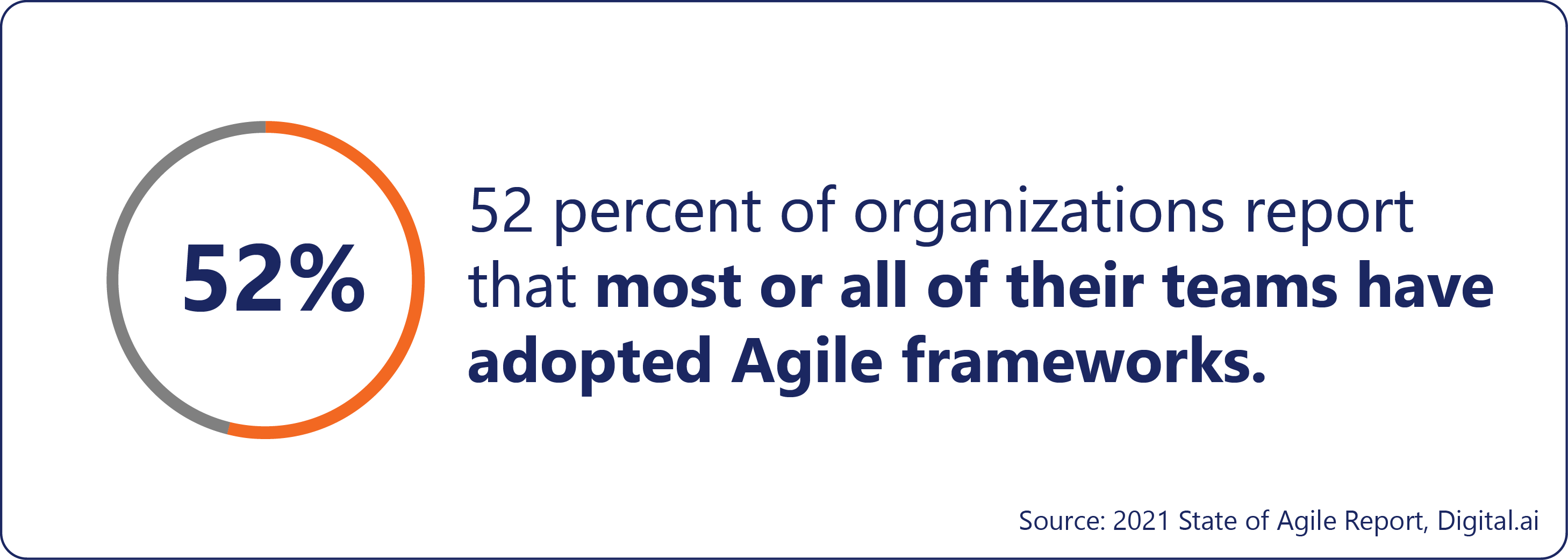
What is Agile transformation?
Agile transformation is far more than simply “doing Agile” or adopting Agile practices on an individual team or department level. True Agile transformation is a process of transitioning the entire organization—across all departments, levels, and teams—to a way of working based on Agile principles and driving a closer connection to customers and feedback.
As one might imagine, achieving this goal is neither quick nor simple. A complete Agile transformation along the lines of what Microsoft has accomplished can take years to complete (and often never truly does). Along the way, the organization may encounter any number of challenges capable of derailing the entire initiative. Fortunately, awareness of the most common challenges—and the solutions that can address them—goes a long way towards ensuring a successful Agile transformation journey.
In this article, I’ll explore the five most common challenges that can interfere with—or, if left unchecked, derail completely—even the most well-planned Agile transformations, and five solutions that can allow organizations to turn roadblocks into speed bumps and continue towards their goals.
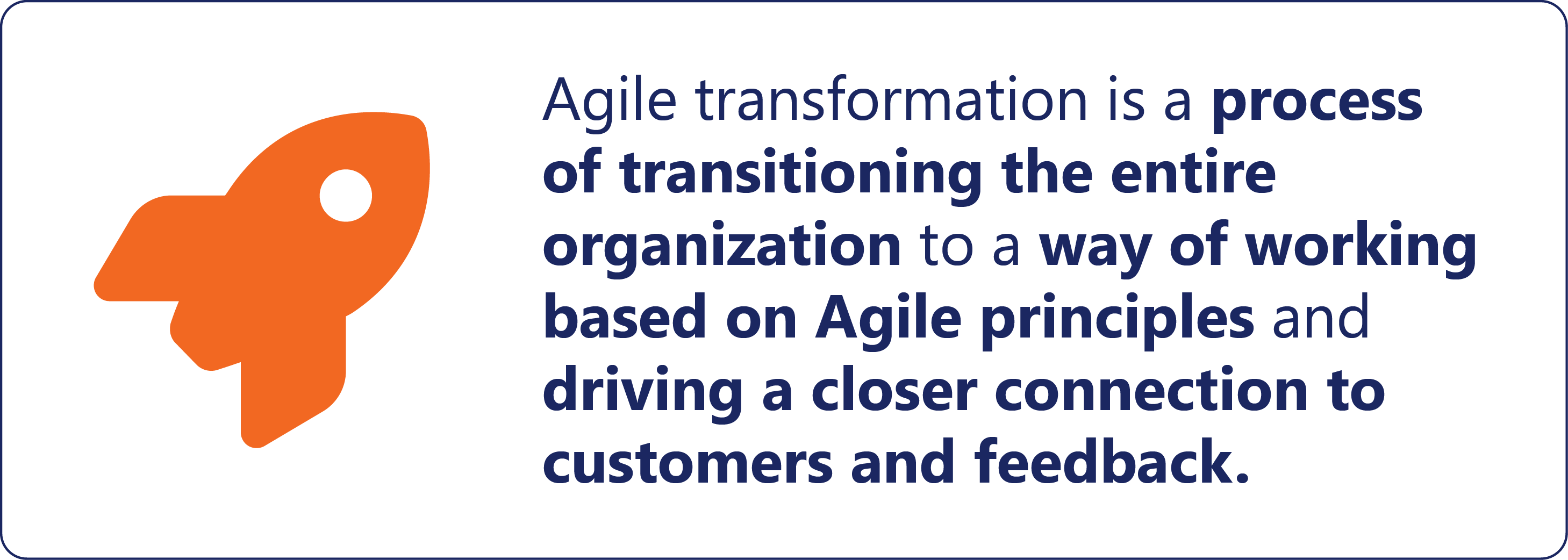
Top 5 Agile transformation challenges
Challenge #1: Lack of executive engagement
One would expect to see an organization-wide strategy to kick off with “gain executive buy-in” or “get C-suite sign-off.” Important, yes. But for a cultural shift of this magnitude, it’s not enough.
Even after “buying in” to Agile transformation, leadership may continue to operate along the same old command-and-control guidelines. “Pet projects” of senior management may continue to be prioritized over those designed to deliver real value to customers. Team members may continue to be evaluated according to volume of work produced rather than value delivered.
Without active, consistent executive engagement—“walking the walk” in addition to talking the talk—the chances of success in achieving Agile transformation are limited at best.
Challenge #2: Continued focus on “delivering stuff”
In an Agile organization, individual and team success is gauged by the value delivered to the customer. Contrast this with the old approach of having monthly, quarterly, or yearly objectives based on the amount of code checked in (or the equivalent on non-technical teams). A true Agile transformation includes assessing the whole ecosystem, looking at performance metrics, KPIs, and even employee incentive programs to make sure customer value and impact is prioritized.
Agile transformation requires a significant cultural shift that won’t happen on its own. As long as expectations (either outside or self-imposed) continue along the old guidelines, there’s little hope for success.
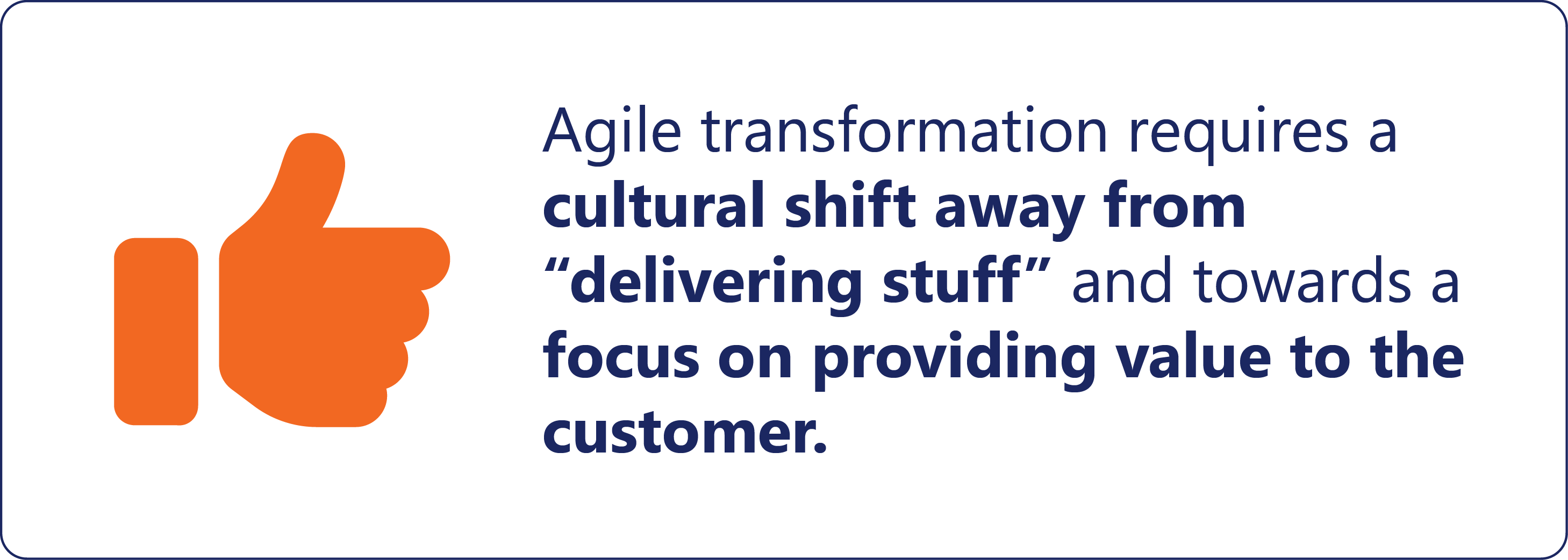
Challenge #3: Lack of reliable customer intel
Let’s say the whole organization gets on board with the Agile concept of value to the customer as the measure of success. The next obvious question to consider is “How are we going to measure that?”
For small organizations, it’s easy enough to pick up the phone and get feedback directly from customers. Larger enterprises, however, need to rely on data. The condition of that data—whether it’s clean, current, reliable, and well-managed—can mean the difference between clear, actionable Agile objectives and murky goals that could erode confidence, perhaps driving teams back to the old “deliver stuff” way of working.
Challenge #4: Lack of consolidated tooling
With more than 50 Agile methods, frameworks, and approaches out there, it’s easy for organizations to wind up with a patchwork of practices that vary considerably from team to team. While the goal of Agile transformation is to bring the entire organization under the Agile banner, varied approaches to tooling can inhibit intra-team collaboration and complicate higher-level management. Inconsistent approaches to value measurement, customer impact, or even evaluating usage and customer feedback can derail the transformation.
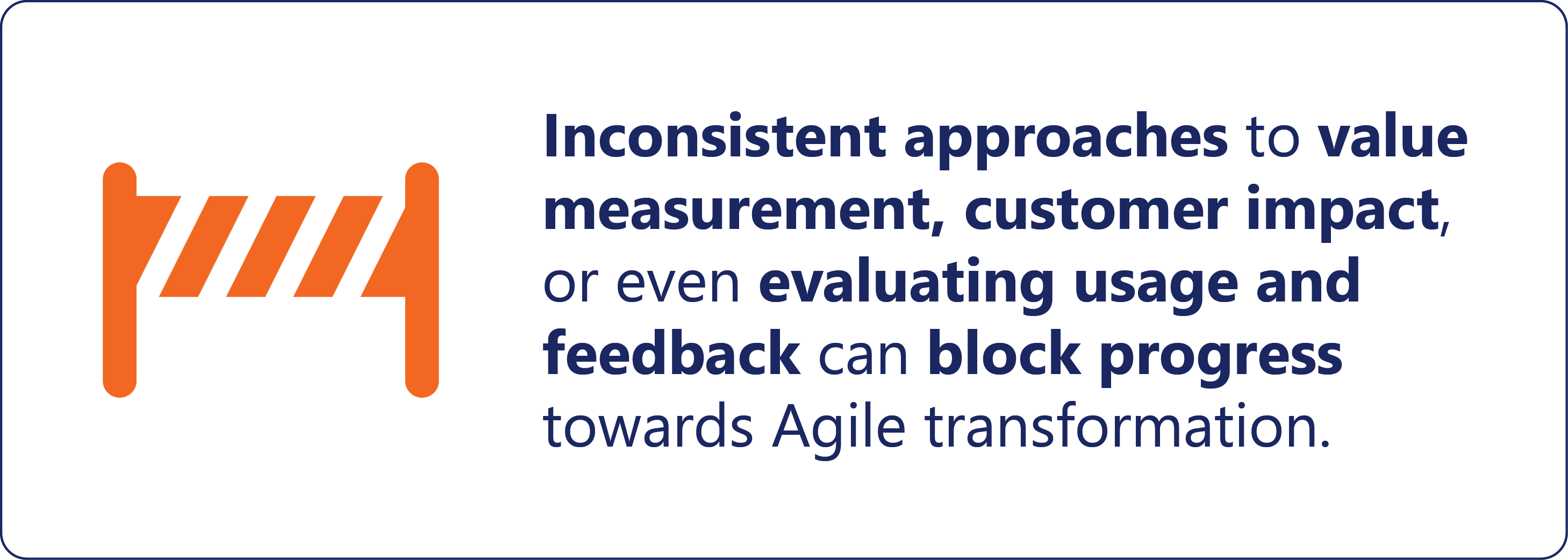
Challenge #5: Lack of clarity on roles and responsibilities
When organizations embark on an Agile transformation, many employees transition to new roles that differ significantly from their old ones. For example, when a project manager becomes a product manager, the new role entails a very different set of functions, objectives, and expectations.
If organizations fail to communicate what new roles entail and provide job-specific training, they run the risk of simply putting a new label on the same job.
Moving forward: top 5 solutions to Agile transformation challenges
Now for the good news: none of the above challenges is insurmountable. We’ve developed a proprietary approach to Agile transformation that anticipates and addresses the most frequently encountered problems—before they have a chance to impact progress towards the ultimate goal.
Solution #1: Implement a change management strategy
Agile transformation is a sweeping, organization-wide cultural change involving dramatic shifts in mindsets, perspectives, and approaches to work. It’s not the kind of thing that can be accomplished with a few training sessions and a handful of memos from the CEO. Winning over an entire organization to the Agile way of working requires a strategic approach, and change management offers a tried-and-true paradigm for implementing long-term changes.
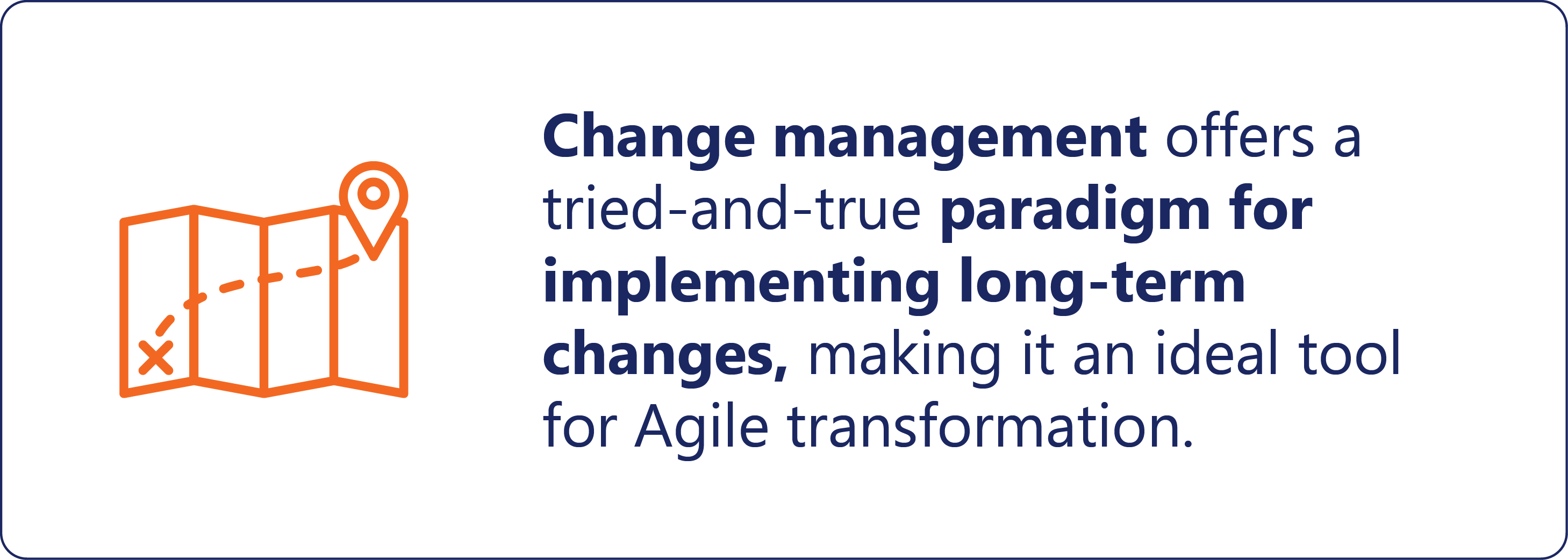
Solution #2: Clarify benefits to employees
As an old marketing saying goes, everyone’s internal radio is tuned into the station WIIFM—“what’s in it for me?” If employees are to get on board with Agile transformation, they need a crystal-clear understanding of how it benefits them on a day-to-day level.
As you implement your change management strategy, make sure to emphasize the many ways Agile methodologies benefit employees, including
• Closer connection between their work and actual benefits to real people
• In development teams, a lower risk of “code bloat”—extraneous code developed for the sake of meeting quotas that needs to be cleaned up later
• Increased personal autonomy
• Greater flexibility
Solution #3: Measure customer impact
Since Agile is all about customer impact, it’s essential to make that impact the focal point of product requirements and implement continuous tracking.
Start by making sure your customer data is clean, current, compliant, and accessible to the people and applications that use it. Determine which metrics best reflect the product’s customer impact, measure a baseline for each, and establish a cadence for reviewing progress throughout each sprint.
Solution #4: Clarify roles and responsibilities
Agile transformation requires the kind of discipline that can only be achieved when everyone knows what is expected of them and has the skills and knowledge required to deliver.
Make sure every team member understands exactly what is expected of them in an Agile environment. If any skill or knowledge gaps need to be filled, these should be addressed through training and coaching as early in the transformation process as possible.
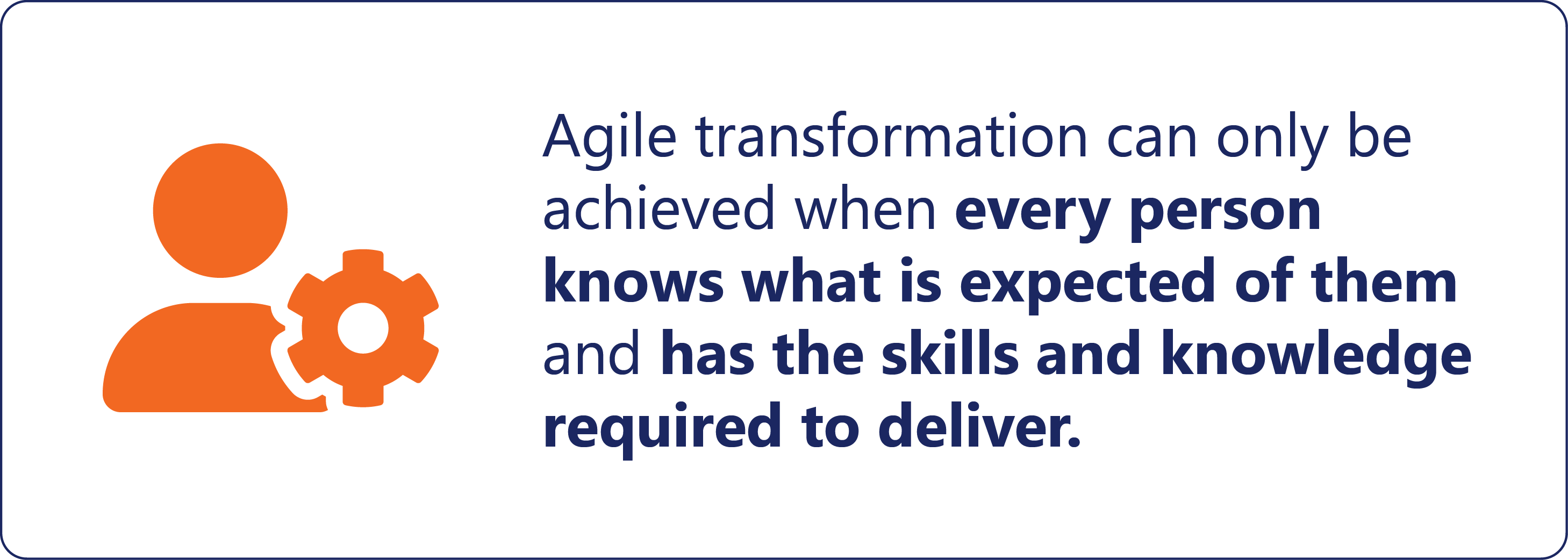
Solution #5: Promote the Agile mindset
A successful Agile transformation involves a shift in ways of thinking about work across the entire organization—from the bureaucratic, top-down, “deliver stuff” mindset to one focused on the four Agile values:
• Individuals and interactions over processes and tools
• Working software over comprehensive documentation
• Customer collaboration over contract negotiation
• Responding to change over following a plan
Since mindsets don’t change overnight, the cultural aspects of Agile transformation are those that require the most time, effort, and consistent perseverance. By developing a long-term strategy that leverages best practices in change management—involving communications, training, coaching, and incentives—businesses can set themselves up to evolve into true Agile organizations.
From Agile adoption to Agile transformation
Even in organizations where Agile adoption has succeeded on a team-by-team basis, the journey to true Agile transformation can take years to complete. Not only does it require patience and persistence, but the plan must also be robust enough to withstand disruptions along the way, such as changes in leadership.
Becoming aware of challenges that will likely arise—and of the solutions that can mitigate them—is an essential first step. When businesses know what they’re facing and can build their responses into a future-proof strategy, bolstered by proven change management principles, achievement of true Agile transformation becomes a real possibility.

